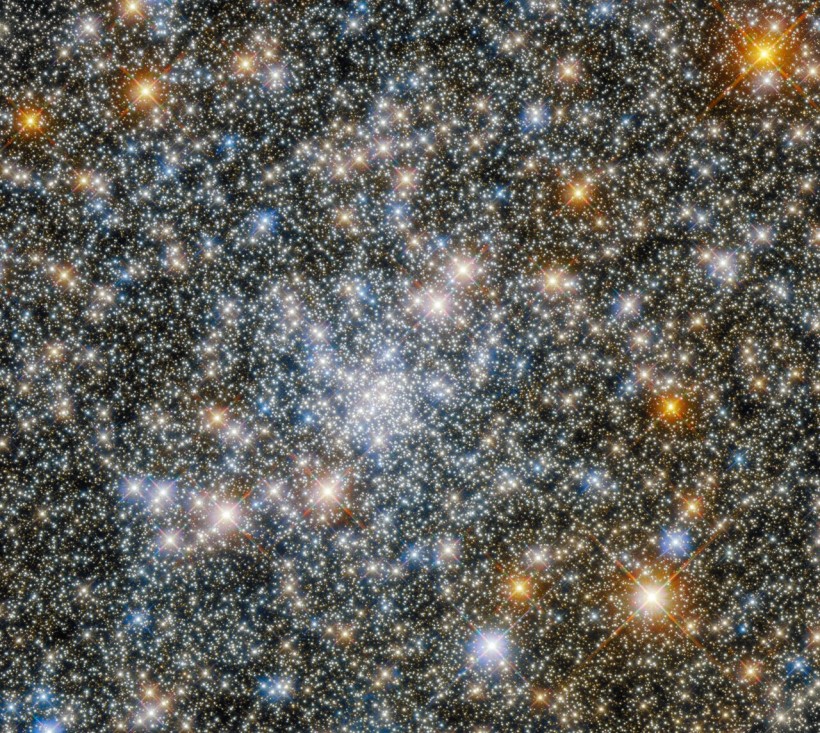
This scintillating image showcases the globular cluster NGC 6540 in the constellation Sagittarius, which was captured by the NASA/ESA Hubble Space Telescope’s Wide Field Camera 3 and Advanced Camera for Surveys.
We never cease to be in awe of the stunning images of space taken by the Hubble Space Telescope. The globular cluster NGC 6540 in the constellation of Sagittarius is depicted in the image you can see above.
NGC 6540
Globular cluster NGC 6540, is a stable, closely bound collection of stars. These clusters can contain tens of thousands to millions of stars, all of which are drawn together by gravitational attraction and kept in close proximity to one another, according to the statement of the European Space Agency (ESA).
Diffraction spikes, or cross-shaped patterns of light, are prominently displayed on the brightest stars in this photograph. Bright objects are surrounded by spikes of light because the internal structure of the telescope slightly alters the starlight's path as it enters the instrument.
In other words, the star does not really have a shape like the image shown in the picture.
In addition, some of the light from these clusters is blocked by the gas and dust that surrounds the galactic center of our galaxy, which also subtly alters the color of their stars.
How Was the Picture Taken
ESa said that the Wide Field Camera 3 (WFC33) and Advanced Camera for Surveys (ACS) on board the NASA/ESA Hubble Space Telescope took this particular picture. The starry sky region that was visible to both instruments is depicted in this composite image.
In order to assist scientists in determining the ages, forms, and structures of globular clusters that are located closer to the Milky Way's center, Hubble gazed into the center of NGC 6540.
Read More: Hubble Space Telescope's Photo of a Jet of Gas From a Young Star Revealed by ESA
Cameras of Hubble Space Telescope
The two main Hubble camera systems for taking pictures of the universe are ACS and WFC3, according to NASA. With the help of these two systems, excellent wide-field imaging is possible over a variety of wavelengths.

Cutaway diagram of the Hubble Space Telescope
ACS is capable of detecting ultraviolet and near-infrared light, but it was originally created for wide-field photography in the visible spectrum. Three different types of cameras, referred to as channels, are used by ACS.
Wide-field images in the visible, infrared, and ultraviolet ranges are provided by WFC3. WFC3 was created to supplement ACS and enhance Hubble's overall imaging capabilities. WFC3 penetrates further into infrared and ultraviolet wavelengths than ACS, which is primarily used for visible-light imaging, offering a more comprehensive perspective of the cosmos.
Past Instruments of Hubble
You did read that correctly. Not all instruments aboard the Hubble Space telescope are original. In fact, according to NASA, just the third Fine Guidance Sensor of Hubble's sensors is still present.
The remaining instruments were added throughout the five servicing missions for Hubble. Following a cryocooler incident, Hubble's Near-Infrared Camera and Multi-Object Spectrometer (NICMOS) is idle; however, WFC3 has since largely taken over NICMOS's infrared responsibilities.
Hubble's past instruments include:
-
Faint Object Camera
-
Faint Object Spectrograph
-
High Speed Photometer
-
Goddard High Resolution Spectrograph
-
Wide Field and Planetary Camera
-
Wide Field and Planetary Camera 2
Related Article: What's the First Ever Photo That the Hubble Space Telescope Ever Took?














